Welcome to vectorportraits.com and this site will teach you how
to make your own vector portraits. Every artist have their own style of
creating a vector portrait ranging from ultra-realistic to very
cartoony. What you’ll learn in this website is my style of making one
and hopefully you can come up with our style after learning the basics
of vector art. Let’s begin.
What you need:
- Basic Photoshop 7 skills (or later)
- A steady hand
- An eye for details
- Some time and patience
Reference Photo:
This photo is what we’re going to work on for this tutorial.
And this is what we will end up with:

Try to use hi-res copies of the pictures that you’d want to convert
into vector portraits because it’ll be easier to see the details and
produce a much better looking vector.
Photoshop Basics:
For this tutorial, we will use Photoshop to create our vector
portraits. Most artist prefer Illustrator for vector graphics but for
this tutorial Photoshop will do. We will use the Pen Tool (PS Shortcut:
P) primarily in creating the vector portrait. This tool is used to
produce vector shapes and the vector shapes that you will create will
ultimately form the portrait that you are working on. If you haven’t
used the pen tool before here’s a primer:
To create a basic vector shape, just click wherever you want to start
on the canvass and continue clicking to create a square shape. Click
again where your shape started to close the shape. A new shape layer
will appear in your layer pallette.
There are two ways to deal with curved shapes using the pen tool. The
first one is to use a curve node which creates a smoother curve and the
other is to use lots of nodes to trace the curve.
Method 1:

After finishing the curve, you can still edit the curve by holding
the CTRL key while still using the pen tool. Your cursor will change to a
plain white arrow to edit any node on your current curve. Just click on
any node and drag it to edit the curve.
Method 2:

This is easier than the first method but may result to not as smooth as
the curve from the first method. All you do is zoom into the curve
that you wanted to trace then click along the curve to create a lot of
nodes which when zoomed out looks like a smooth curve.
Before we start:
We need to set the pen tool options and shape options

Click on the pen tool or press P on your keyboard then check the
settings for the pen tool options and shape options. This is the basic
set up we will use on working on our vector portraits. We will use
different shape option a little bit later on the tutorial. I guess we’re
all set so click the link below to start with the next part.
First right click on this image and save it on your desktop and open it on photoshop

Duplicate the current layer by pressing CTRL+J then go to Image>Adjustment>Posterize. Type 7 in the levels input box.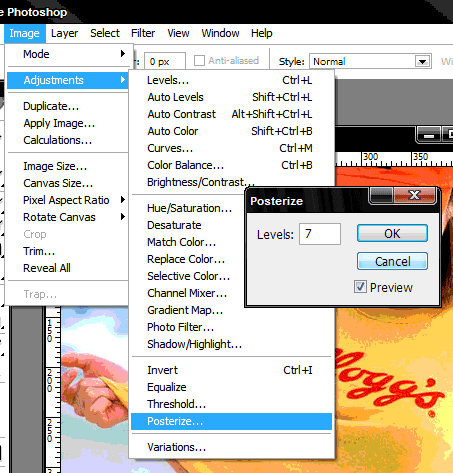
The posterized layer will serve as a guide to the shades of color
that we need to trace. The higher the level of posterizing you use the
more realistic your vector will look but it will also be more difficult
to work on.
Now press F to go into fullscreen mode, this will make tracing shapes
easier. Zoom in at around 300% using the zoom tool, then hold down the
space bar (your cursor will change to a hand) click and drag the image
so that you are looking at the part of the picture same as below. 
Click on the background layer to activate it then press P to select
the pen tool, using the above image as a reference click on the starting
point. You will notice that a new layer is created named "Shape 1″ on
the Layers Palette. That is normal and this simply means that we are
working on a vector shape. Follow the guide below to start tracing the
outline of the skin of the model in the picture.
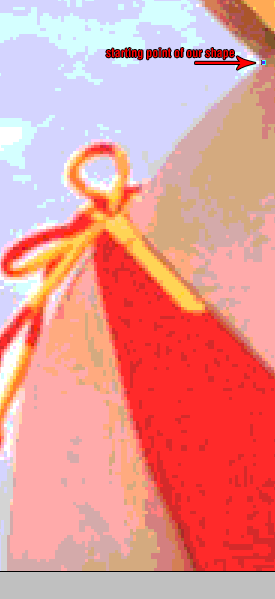

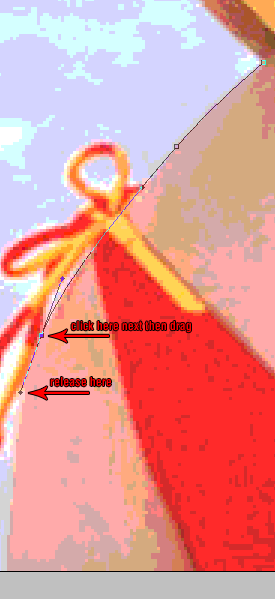
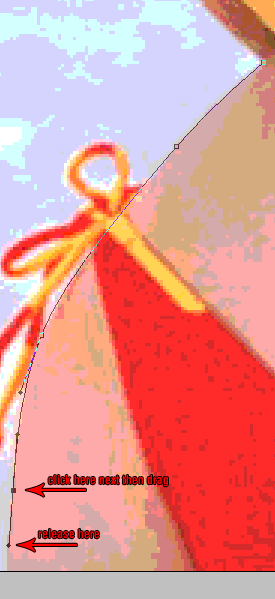

You may notice that I intentionally placed a node outside the
picture, you don’t have to worry about this because any nodes outside
the picture will not show and will not affect the vector. Also, in case
you made a mistake or the curved path did not fit well you can hit
CTRL+Z to undo. You can also edit any past node by holding the CTRL
button and drag any node that you want to edit.
Continue tracing the shape until you have something like the image below:
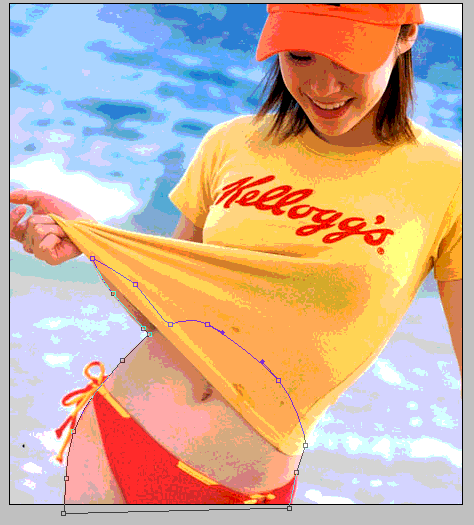
What we are doing here is to trace first all the skin parts. Finish
tracing the belly and the leg part, don’t forget to close you shape.
Click on the "add to shape area” on the shape options.
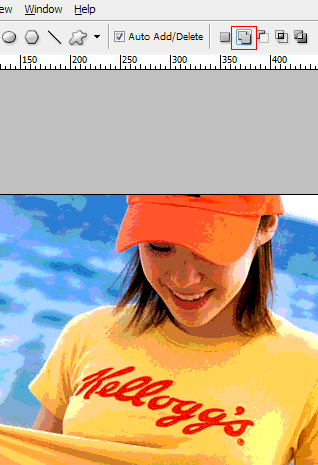
What this does is to add the next vector shape in the same layer.
This way we can keep our layer organized and easier to edit in case we
need to come back and correct something. Continue tracing the other skin
shapes so you may end up with something like this:

And this is what your layers palette should look like:
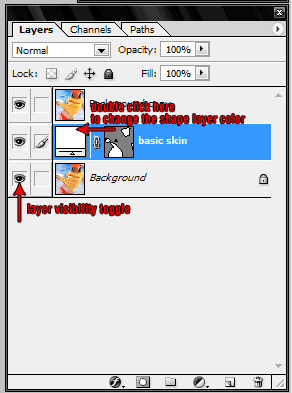
The top layer is your posterized picture, the middle layer is the
shape layer which ou are working on and the bottom layer is the original
picture. You can toggle on and off a layer by clicking on the layer
visibility toggle icon. You can turn off the top layer so you can see
how are you doing with your vector. Double click the box found on the
left side of you shape layer to change its color. Select a color that is
close to the primary skin color of our model (I used #F7CDB8). This
will be the basic skin color of our vector, you will add highlights and
shadows later to this to finish the vector skin.
Here’s what your current work should look like with the posterized layer turned off:

Using the posterized layer as a guide, we’ll start tracing shapes
that will be details of our model’s skin. Lets concentrate on the belly
and leg part first. When you posterized your picture’s color depth was
reduced and the boundaries of the shades are shown. Take a look at the
image below, it is a zoomed in picture of the posterized belly part.
You’ll just have to trace every color that you see in this picture.
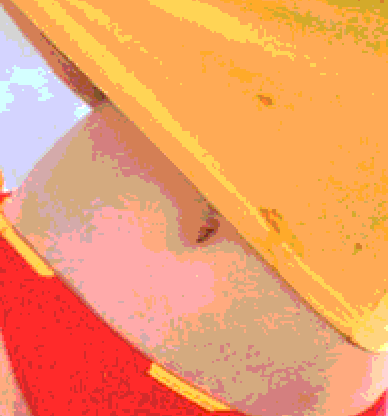
This is where you’re going to need the patience part. It really takes
awhile to finish a vector portrait. You can also see clearly which
color is on top of other color. Basically darker shades should be on top
of a lighter shade. Every color shade must also have its own shape
layer. You can create a new shape layer by clicking on create a new
shape layer option in the shape tools option box. Don’t forget to use
the add to shape area option to add a new shape in the current shape
layer. The following thumbs are arrange in order in which they are
created with the last thumb as the top most layer.


You will notice that each color shades have a very slight difference.
Also the last 3 frames are actually highlights. I usually trace
highlights after I work on the darker shades. Color are selected by
moving the color selector slightly towards the darker side of the color
palette or lighter side of the palette, depending if you’re working on
shadows or highlights. Here’s what it looks like when its put all
together:

Notice the details that are showing on the belly part of the skin.
Using the same techniques, continue working on the shading and
highlights for the other skin parts. You can organize your layers using
the layer folders found on the layer palette. I highly recommend that
each part should have its own folder.
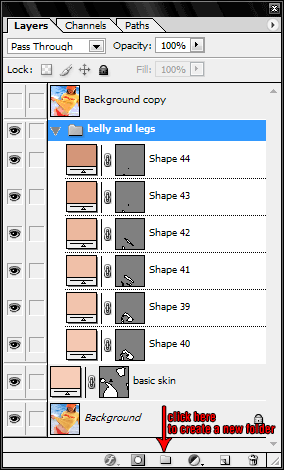
Simply drag a layer to the folder that you created to include it in
that set. Also, mind your layer arrangement. After you finished working
on the other skin parts, here’s what you should have by now.

This is with the posterized layer off and the background layer on. Click on the link below to proceed with the tutorial.
Now that we are finished with the skin, it’s time we do the clothes.
Using the same techniques on tracing the skin, it’s going to be the same
with the clothes and even easier. Using the pen tool and create a new
shape layer and trace around the yellow top. This is how it should look
like after you trace the shape of the yellow top.

Once you get a hang of it and if you finished tracing the skin and
its shadows and highlights, you won’t have a hard time tracing the
shirt. The red bikini is also made on a different shape layer so as the string design for the bikini. Here’s what it should look like.

You can really see now the details of what we have been working on.
Now the only thing missing is the word "Kellogg’s” on the shirt. Just
trace the shape of the word as usual and don’t worry about the holes on
"e”, "o”, "gg” and "s” yet.
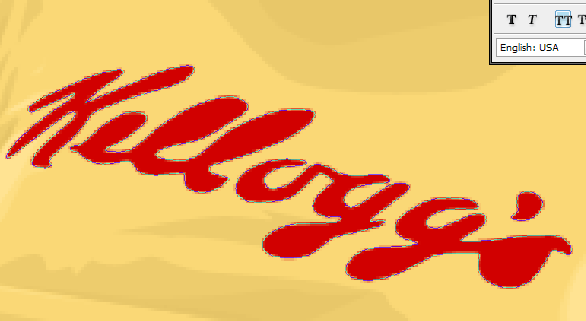
On the same shape layer trace the holes of the letters.
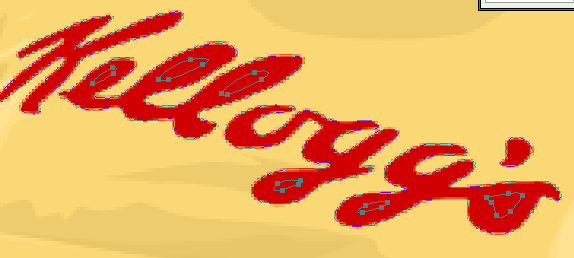
After tracing all the holes, use the path selection tool  to select all the holes that you made for the letter then click on the
subtract from shape area option on your shape options tool box.
to select all the holes that you made for the letter then click on the
subtract from shape area option on your shape options tool box.

This will make the hole paths negative thus becoming a hole on the word. Check it out.

After that we can add the facial details and the hair and we’re almost done. This is how your work should look like by now.

Move on now to the next page for the facial details, hair and the baseball cap.
Now we will work on the details for the face, the hair and the
baseball cap. Again, once you really get a hang of this it’ll be easy
for you to work on any picture. Its just a matter of how much details
you’d want to put into the portrait. First we’ll work on the eyes,
actually just the right eye. As you might have noticed our model is
looking and down so not much details will be needed for her eye.
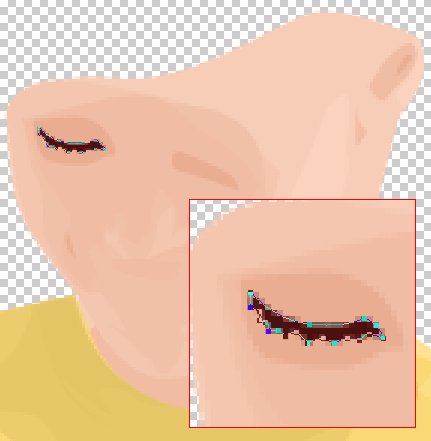
That’s it were done with the eye. Check out the image below of other eyes that I worked on from my other vectors.

You might notice that I do’t put much details on the eyes of my works
but don’t let that stop you. You can put a lot of details when you’re
working on your own vectors.
To trace the mouth, first trace the shape of the lips. Don’t forget
the whole for the mouth, use the steps that we did when tracing the word
"Kellogg’s” on her shirt.

Using the posterized layer as a guide, add shadows and highlights on the lips.

The color changes are subtle but when you look at the portrait the details really makes difference.
For the teeth, create a shape layer under the lips layer and fill it up with white then add the shadows to complete the mouth.

The mouth shadow layer is sandwich between the teeth and the lips layers. Here’s what our face currently looks like.

We now move on to the hair. The hair layer should be done on top of
the skin layers. Just trace the hair as you normally would. Try to
include the as much of the fly away strands as you can.
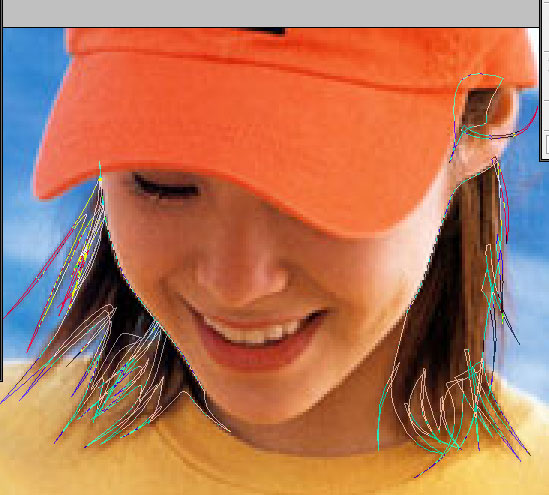
Here’s what it should look like with the original photo layer turned off:
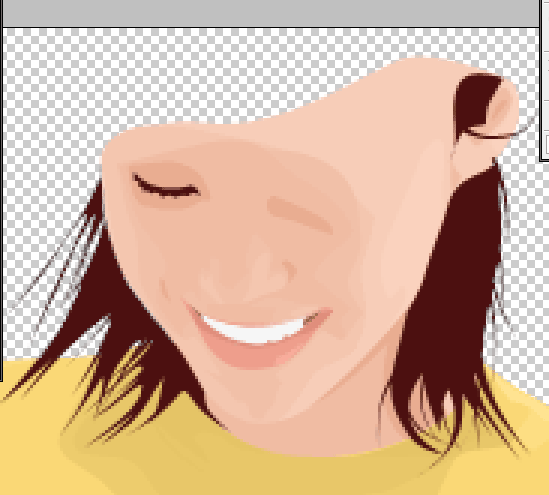
We need to add shadows and highlights to the hair to give it texture and not flat.
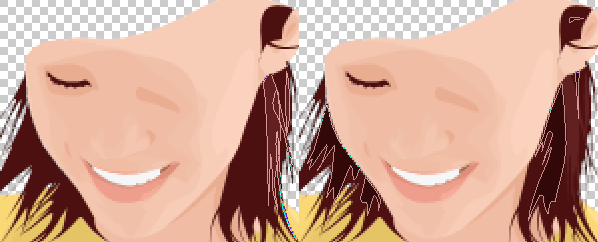
We’re don with the hair. Here’s what should our work should look like now.
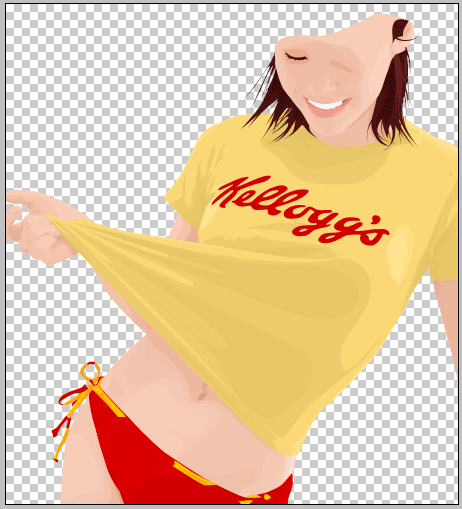
Now just finish it off with the baseball cap and create a background and you’re done.
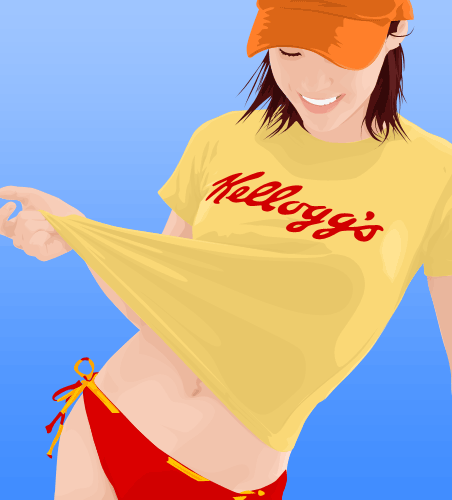
If you need the reference psd for this tutorial you can download it from here.
I really hope that his tutorial was able to teach you what you needed
to learn to work on your own vector portrait. Please do visit our
gallery section to view more samples and submit any vector that you
worked on using this tutorial. You may also email me for clarification
or any suggestion on improving this tutorial.
Lastly, let me be the first to say Congratulations on your first vector!
vectorportraits.com
